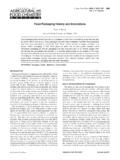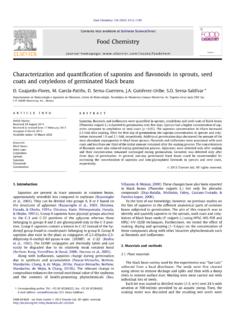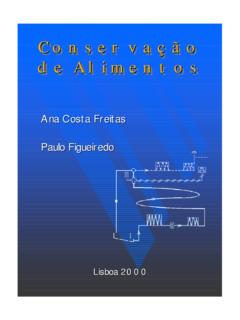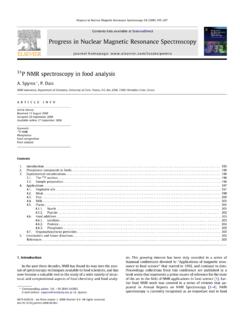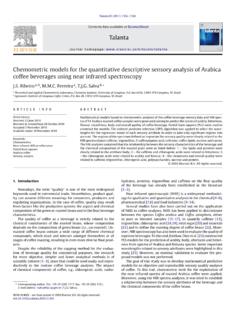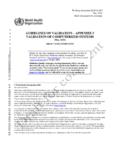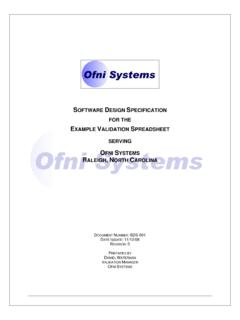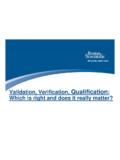Transcription of Method Validation - pfigueiredo.org
1 ZIntroduction zStrategy for Validation of Methods zValidation of Standard Methods zRevalidation zParameters for Method Validation zSelectivity/specificity zPrecision and Reproducibility zAccuracy and recovery zLinearity and calibration curve zRange zLimit of Detection and Quantitation zRobustness zReferences go back to top Please Note: For convenient and trouble free implementation you can download a standard operating procedure for Method Validation from the Users Club section. Introduction Method Validation is the process to confirm that the analytical procedure employed for a specific test is suitable for its intended use. Methods need to be validated or revalidated zbefore their introduction into routine use zwhenever the conditions change for which the Method has been validated, , instrument with different characteristics zwhenever the Method is changed, and the change is outside the original scope of the Method .
2 Method Validation has received considerable attention in literature and from industrial committees and regulatory agencies. The Guidance on the Interpretation of the EN 45000 Series of Standards and ISO/IEC Guide 25 includes a chapter on the Validation of methods (1) with a list of nine Validation parameters. The International Conference on Harmonization (ICH) of Technical Requirements for the Registration of Pharmaceuticals for Human Use Method Validation Learn from the convenience of your desk or with your colleagues in your seminar room Validation of Analytical Methods and Procedures Design, Conduct and Document for Efficiency and Compliance P gina Web 1 de 1613-10-2006 (2) has developed a consensus text on the Validation of analytical procedures. The document includes definitions for eight Validation characteristics.
3 An extension with more detailed methodology is in preparation and nearly completed (3). The United States Environmental Protection Agency (US EPA) prepared a guidance for methods development and Validation for the Resource Conservation and Recovery Act (RCRA) (4). The American Association of Official Analytical Chemists (AOAC), the United States Environmental Protection Agency (USP) and other scientific organizations provide methods that are validated through multi-laboratory studies. The United States Food and Drug Administration (US FDA) has proposed guidelines on submitting samples and analytical data for methods Validation (5-7). The United States Pharmacopoeia (USP) has published specific guidelines for Method Validation for compound evaluation (8). There are no official guidelines referring to biological fluids.
4 The pharmaceutical industry uses methodology published in the literature (9,10). The most comprehensive document was published as the Conference Report of the Washington Conference on Analytical Methods Validation : Bioavailability, Bioequivalence and Pharmacokinetic Studies held in 1990 (sponsored by the American Association of Pharmaceutical Scientists, the AOAC and the US FDA, among others) (10). The report presents guiding principles for Validation of studies in both human and animal subjects that may be referred to in developing future formal guidelines. Representatives of the pharmaceutical and chemical industry have published papers on the Validation of analytical methods. Hokanson (11,12 ) applied the life cycle approach, developed for computerized systems, to the Validation and revalidation of methods.
5 Green (13) gave a practical guide for analytical Method Validation with a description of a set of minimum requirements for a Method . Renger and his colleagues (14) described the Validation of a specific analytical procedure for the analysis of theophylline in a tablet using high performance thin layer chromatography (HPTLC). The Validation procedure in that article is based on requirements for European Union multistate registration. Wegscheider (15) has published procedures for Method Validation with special focus on calibration, recovery experiments, Method comparison and investigation of ruggedness. The association of official analytical chemists (AOAC) (16) has developed a Peer-Verified Methods Validation program with detailed guidelines on what parameters should be validated.
6 This article gives a review and a strategy for the Validation of analytical methods for both in-house developed as well as standard methods and a recommendation on the documentation that should be produced during and at the end of Method Validation . go back to top Strategy for Validation of Methods The validity of a specific Method should be demonstrated in laboratory experiments using samples or standards that are similar to the unknown samples analyzed in the routine. The preparation and execution should follow a Validation protocol, preferably written in a step by step instruction format. Possible steps for a complete Method Validation are listed in table gina Web 2 de 1613-10-2006 a Validation protocol or operating procedure for the Validation the application, purpose and scope of the Method the performance parameters and acceptance criteria Validation experiments relevant performance characteristics of equipment materials, standards and reagents pre- Validation experiments Method parameters or/and acceptance criteria if necessary full internal (and external) Validation experiments SOPs for executing the Method in the routine criteria for revalidation type and frequency of system suitability tests and/or analytical quality control (AQC)
7 Checks for the routine Validation experiments and results in the Validation report Table 1. Steps in Method Validation First the scope of the Method and its Validation criteria should be defined. These include: zcompounds, zmatrices, ztype of information: qualitative or quantitative, zdetection and quantitation limits, zlinear range, zprecision and accuracy ztype of equipment and location The Method s performance characteristics should be based on the intended use of the Method . For example, if the Method will be used for qualitative trace level analysis, there is no need to test and validate the Method s linearity over the full dynamic range of the equipment. Initial parameters should be chosen according to the analyst s best judgment. Finally, parameters should be agreed between the lab generating the data and the client using the data.
8 The scope of the Method should include the different types of equipment and the locations where the Method will be run. For example, if the Method is to be run on one specific instrument in one specific laboratory, there is no need to use instruments from other vendors or to include other laboratories in the Validation experiments. In this way the experiments can be limited to what is really necessary. Before an instrument is used to validate a Method , its performance should be verified using generic standards (18,19). Satisfactory results for a Method can only be obtained with well-performing equipment. Special attention should be paid to the equipment characteristics that are critical for the Method . For example, if detection limit is critical for a specific Method , the instrument s specification for baseline noise and, for certain detectors also the response to specified compounds, should be verified.
9 Any material used to determine critical Validation parameters, such as reagents and reference standards, should be checked for accurate composition and gina Web 3 de 1613-10-2006 there is no or little information on the Method s performance characteristics, it is recommended to prove the methods suitability for its intended use in initial experiments. These studies should include the approximate precision, working range and detection limits. If the preliminary Validation data appear to be inappropriate, either the Method itself, the equipment, the analysis technique or the acceptance limits should be changed. In this way Method development and Validation is an iterative process. For example, in liquid chromatography selectivity is achieved through selection of mobile phase composition.
10 For quantitative measurements the resolution factor between two peaks should be or higher. If this value is not achieved, the mobile phase composition needs further optimization. There are no official guidelines on the sequence of Validation experiments and the optimal sequence can depend on the Method itself. Based on my experience, for a liquid chromatographic Method the following sequence has been proven to be useful: of standards (optimizing separation and detection of standard mixtures) of retention times and peak areas , limit of quantitation, limit of detection, range with real samples , at different concentrations (interlaboratory studies) The more time consuming experiments such as accuracy and ruggedness are put towards the end. Some of the parameters as listed under two to five can be measured in combined experiments.
